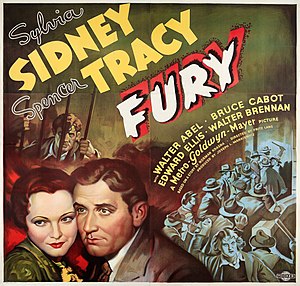Fury (1936 film)
Jump to navigation
Jump to search
| Fury (1936 film) | ||||||||||||||||||||||||||
|---|---|---|---|---|---|---|---|---|---|---|---|---|---|---|---|---|---|---|---|---|---|---|---|---|---|---|
This film has been preserved in the National Film Registry in 1995.
| ||||||||||||||||||||||||||
 | ||||||||||||||||||||||||||
|
Fury is a 1936 American drama film directed by Fritz Lang that tells the story of an innocent man (Spencer Tracy) who narrowly escapes being burned to death by a lynch mob and the revenge he then seeks. The film was released by Metro-Goldwyn-Mayer and stars Sylvia Sidney and Tracy, with a supporting cast featuring Walter Abel, Bruce Cabot, Edward Ellis and Walter Brennan. Loosely based on the events surrounding the Brooke Hart murder in San Jose, California, the film was adapted by Bartlett Cormack and Lang from the story Mob Rule by Norman Krasna. Fury was Lang's first American film.
Why It Rocks
- After fleeing Nazi Germany in the early 1930s, going to the United States and being hired at MGM, Fritz Lang would be given a 4-page outline called "Mob Rule", which he'd combine with a real-life lynching that occurred in San Jose, California in late 1933. His story showed how prejudice and bigotry could turn ordinary people into a violent mob.
- The film concerns an auto mechanic falsely arrested for a murder, and citizens in the small town -- roused to action by gossip and lies -- attack the jail where the man's being held, determined to lynch him. The man was a lawyer in early drafts, but the crew changed the man's position as they wanted the protagonist to be a working man who couldn't express himself, as events like this were more likely to occur to ordinary people rather than powerful authority figures.
- This film doesn't offer easy answers. The story's carefully established, with sweethearts Joe and Katherine being introduced as ordinary people, Joe being given stricter morals than his brothers, and explanation being provided as to why Joe doesn’t understand the potential danger following his arrest for a kidnapping and murder. The film is a mirror reflecting an image of people like ourselves. Viewers empathize with these characters and this makes what happens to them even more horrifying. What happens to Joe and Kate could happen to anyone and this is what makes the film so powerful.
- Fritz Lang documents the growing hysteria surrounding Joe’s imprisonment with the same cool paranoia he brought to M and his Dr. Mabuse films, at the same time singling out lawyers and the media for criticism decades before films like Ace in the Hole. The film shines a spotlight on social justice by exploring social injustice. It’s a time capsule; a look into a period of time when public lynchings were still common. It was a time when people wanted to see criminals punished publicly in front of their own eyes. Fury explores the public’s urgent need for swift punishment and the media’s exploitation of crime to tantalize readers.
- Despite the film's faults, the first hour of the movie shows a small-town America that had never been seen on the screen before, with the story’s inexorable drive making it among the more powerful movies of its period. What especially shocked viewers at the time was how character actors who typically played friendly townsfolk in Frank Capra and Preston Sturges films were playing drastically against type as bloodthirsty vigilantes.
- Although it's an MGM movie, it doesn't look like a film they'd typically make, either in its cast or its production design, and certainly not in its moral. The studio generally avoided message dramas, and wouldn't directly address social issues again until Intruder in the Dust. In general, it feels more like a political or social film Warner Bros. would made during the same era. It takes a critical look at corporal punishment and highlights the flaws in the American justice system. With the Hays Code in strict enforcement in 1936, it was necessary for the film to end a certain way. Joe was only pretending to be dead so the mob he took to court, with the help of his brothers, have to be acquitted. The film’s happy ending, a meeting and reconciliation between fiancées Joe and Kate, was typical of studio era films.
- Spencer Tracy does an incredible job as Joe Wilson with his performance demonstrating his range as an actor. His character morphs from an innocent and loveable guy into an embittered man thirsty for revenge.
- Sylvia Sidney does a great job as Katherine Grant
- Other notable cast members of include Bruce Cabot, Walter Brennan, Walter Abel, Frank Albertson and Terry, who plays Rainbow the dog and would later play Toto in The Wizard of Oz
Bad Qualities
- There are some notable cracks in the film's logic, especially concerning Joe’s alibi, and the film derails in its second half as Joe concocts a far-fetched revenge scheme.